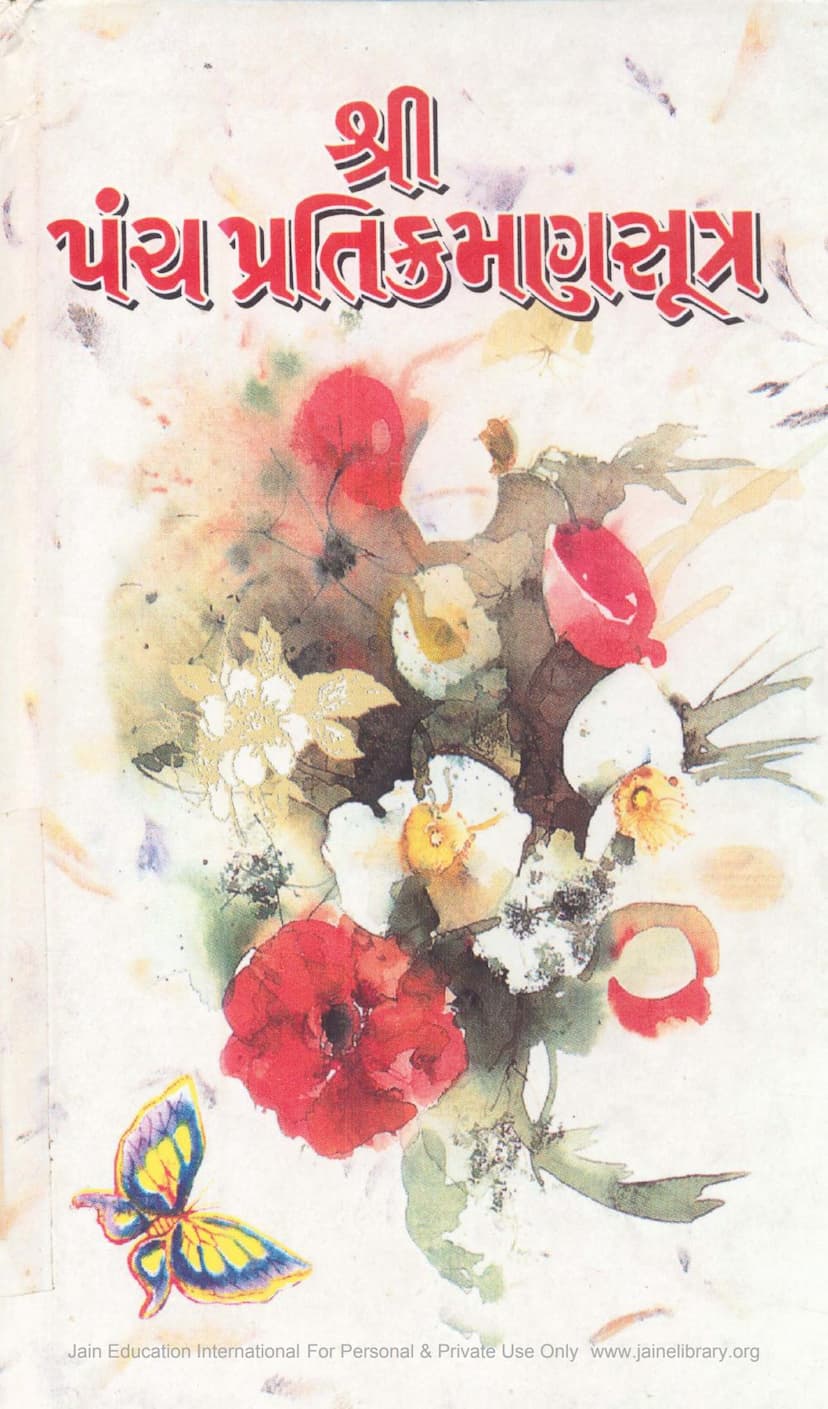Panch Pratikraman Sutra
Added to library: September 2, 2025

Summary
Here's a comprehensive summary of the "Panch Pratikraman Sutra" based on the provided text, aiming to capture its essence and key components:
Book Title: Panch Pratikraman Sutra Author(s): Sukrutnidhi Trust Publisher: Sukrutnidhi Trust Catalog Link: https://jainqq.org/explore/005540/1
Overall Purpose:
The "Panch Pratikraman Sutra" is a foundational Jain text that serves as a guide for performing "Pratikraman," a ritual of confession, repentance, and purification. It outlines the specific verses, prayers, and procedures involved in various types of Pratikraman, essential for spiritual progress in Jainism. The book aims to provide a clear and accessible version of these important scriptures, often emphasizing the correct pronunciation and understanding of the underlying meters (chandas) of the verses.
Key Components and Themes:
-
Pratikraman Rituals: The core of the book is dedicated to the detailed explanation and recitation of various Pratikraman rituals. These are presented as crucial for shedding accumulated karma and advancing spiritually. The text covers:
- Devasik Pratikraman: The daily Pratikraman.
- Pakhsik Pratikraman: The fortnightly Pratikraman.
- Chaturmasik Pratikraman: The quarterly Pratikraman.
- Samvatsari Pratikraman: The annual Pratikraman.
-
Core Sutras and Prayers: The book meticulously lists and explains numerous essential Jain sutras and prayers that form the backbone of these rituals. These include:
- Namaskar Mahamantra (Panchmangal Sutra): The fundamental five-line mantra, considered the greatest of all auspicious prayers.
- Panchiy Sutra (Gun Sthapana): Describing the virtues of the Acharyas.
- Khmasaman Sutra: A request for forgiveness.
- Ichchakar Sutra: A polite request for permission or guidance.
- Abhutthiao Sutra: A prayer of confession for errors.
- Iriyavahiyam Sutra: Repentance for unintentional harm to living beings while moving.
- Tassa Uttari Sutra: The purpose of continuing the penitential acts.
- Annatth Sutra: Used for Kausagga (meditation/austerity).
- Lokas Sutra (Namastav Sutra): Praising the 24 Tirthankaras.
- Karemi Bhante Sutra: The vow to perform Samayik.
- Samayik Sutra: Explaining the significance and practice of Samayik (equanimity).
- Chaitya Vandan Sutras: Verses for worshipping Jain idols and temples (e.g., Jagachintamani, Namuthana, Javanti Cheai, Siddhann Buddhanu, etc.).
- Visahar Stotra: Hymn to Lord Parshvanath, dispelling obstacles.
- Jay Virayay Sutra: A prayer for devotion and spiritual attainment.
- Arhant Cheiyana Sutra: Kausagga for worship of Jain idols.
- Kalyanakand Sutra: Stuti of five Tirthankaras and other important deities.
- Samsaravanal Stuti: Stuti relating to the cycle of birth and death.
- Pukharavar Dive Sutra: Praising Shruta Jnana (scriptural knowledge).
- Siddhana Buddhana Sutra: Praising the Siddhas.
- Veyavachchhadha Sutra: For the welfare of the Sangh.
- Bhagvanadi Vanda Sutra: Namaskar to the Panch Parmeshthi.
- Devasisi Padimane Thau Sutra: Short confession for the day.
- Ichchhami Khami Sutra: Detailed confession of transgressions.
- Panchaachar Sutra: Verses related to the five conduct principles (Jnana, Darshan, Charitra, Tapa, Virya) and their transgressions.
- Posa-kh Pachkhan and Sutras: Vows for fasting and related practices.
- Shantisutra: Hymns for peace and well-being.
- Bhaktamar Stotra: A famous hymn known for its miraculous properties.
- Chaukasay Sutra: Verses praising Lord Parshvanath.
- Bharheshar Sajhay and Mannaih Jinani Sajhay: Narratives and hymns associated with prominent individuals and practices.
- Sakala Tirtha Vunta: A pilgrimage description and enumeration of holy sites.
- Aadhnna Sutras: Various prayers and stutis.
-
Emphasis on Metre (Chanda): A significant aspect highlighted in the book is the importance of understanding and reciting the verses according to their specific meters. The "Pratikraman" verses are often composed in various poetic meters like Gatha, Rola, Vastru, Padakula, etc. The text emphasizes that proper recitation following these meters enhances the sweetness and devotional impact of the prayers. The editor or compiler makes a point of encouraging religious teachers to learn the correct pronunciation and rhythm from experts.
-
Textual Purity and Corrections: The book acknowledges the need for textual accuracy and mentions efforts to purify and correct certain verses based on scholarly considerations and the "Prabodh Tika" (commentary). Examples of specific textual corrections are provided.
-
Guidance and Devotion: The publication is presented with reverence, expressing gratitude to spiritual guides and emphasizing the role of knowledge and devotion in spiritual practice. The introductory sections often include prayers to Goddess Saraswati.
-
Practical Aspects: The book also includes practical instructions on how to perform the rituals, including the necessary items for Samayik, and the correct procedure for various steps like establishing "Sthapanaji" (representations of spiritual authorities) and performing Kausagga.
-
Celebration of Jain Heritage: The text enumerates the names, symbols, and colors of the 24 Tirthankaras, providing a foundational understanding of Jain iconography and history. It also includes various stotras and vandans dedicated to specific Tirthankaras and revered figures.
Target Audience and Contribution:
This book is intended for Jain practitioners, scholars, and anyone seeking to understand and perform Pratikraman rituals correctly. It serves as a valuable resource for devotional practice, spiritual discipline, and the preservation of Jain traditions. By providing the sutras with attention to their metrical structure and textual accuracy, Sukrutnidhi Trust aims to facilitate a deeper and more meaningful engagement with these sacred Jain texts.